Crunchy cucumbers are one of the main ingredients in salads, and people love growing them in the garden. Soil with the correct characteristics, pH level, and nutrients is the only key to encouraging plants to produce quality cucumbers.
Cucumber plants prefer well-drained, fertile, and loamy soil with a pH range of 6.0 to 6.5. The soil should be slightly acidic, rich in organic matter, and have good drainage capacity. However, adequate soil moisture is essential for healthy plant growth and fruit development.
When it comes to soil, there are many things to know and consider. If you are a beginner and searching for the right soil type for cucumbers, stay tuned till the end to learn everything about cucumber soil requirements.
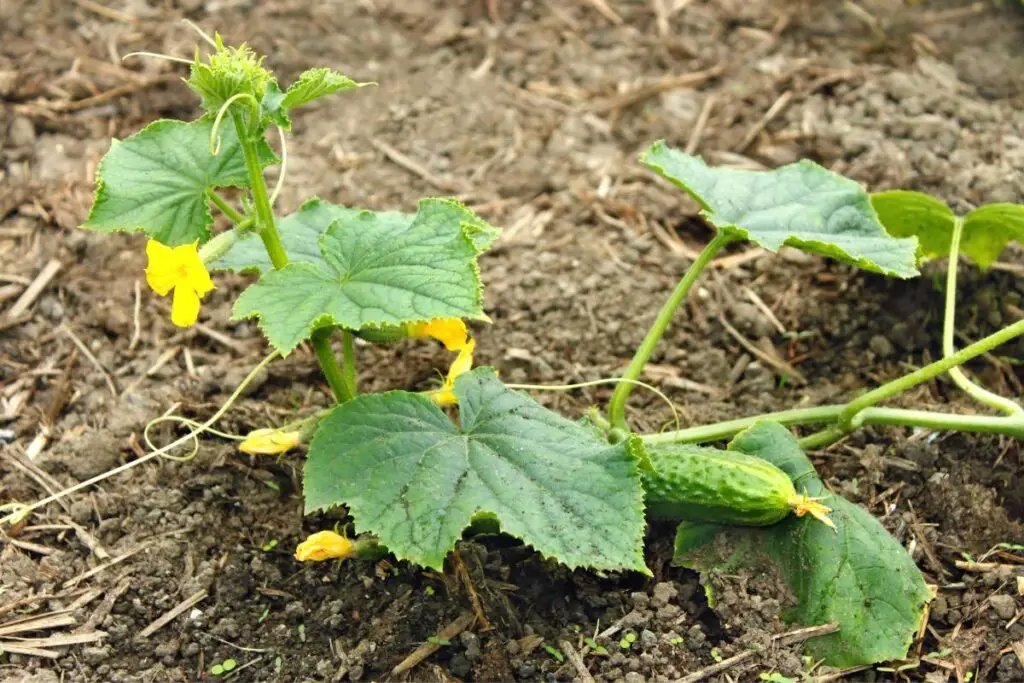
Importance of soil for cucumber plants
Soil is significant for all plants, and cucumbers are no exception.
The plant will receive all its nutrients, like phosphorus, potassium, nitrogen, zinc, iron, calcium, etc., from the soil.
The soil acts as a water reservoir for the plant.
It receives all the moisture from the soil; without this, the plant cannot survive.
Also, soil provides physical support to the cucumbers for growing the roots, stems, and leaves.
It keeps the plant straight and makes nutrient and moisture absorption easier.
Healthy soil is one of the most important factors behind successful cucumber growth.
Healthy soil provides:
- Essential nutrients.
- Proper drainage and moisture retention.
- A good structure for root growth.
Good soil will also contain beneficial microorganisms which make the plants hardy and helps them resist infestations.
Characteristics of soil that cucumber plants prefer
Generally, cucumber plants prefer well-drained soil rich in organic matter and slightly acidic.
But this is not enough knowledge about the soil requirements.
As a beginner, I was baffled while researching the suitable soil for the cucumber plants.
There were many things to know and consider.
Fortunately, after much analysis, research, and some expert advice, I came over to know the right soil type.
Below, I have shortlisted the primary characteristics of the soil preferred by the cucumber plants:
Soil texture and structure
The texture of the soil must be loose and well-aerated.
It will allow the excess water to drain quickly.
Moreover, the roots can receive enough oxygen to breathe and transport the moisture and nutrients to other plant parts.
Drainage
The soil needs to be a perfect blend of sandy and loamy soil.
To improve drainage, add perlite or sand to the soil.
The best way to improve the drainage for the soil beds is to make a slight slope bed to let the water flow.
You may not need this if your planting site receives enough sunlight.
Soil pH level
Cucumber plants will prefer a perfect pH level. They need slightly acidic soil in nature.
Keep the soil’s pH level between 6.0 and 6.5. A higher or lower pH can badly affect the cucumbers’ overall growth and development.
I prefer checking the pH before and after preparing the soil with a pH meter or litmus paper.
Add natural acidic elements like lime or vinegar for soil with a lower pH.
Use aluminum sulfate, mild sulfuric acid, and sulfur for higher pH.
Nutrient requirements
Loamy soil is insufficient if it cannot give the cucumbers enough nutrition.
For that, you must prepare the soil with nutritious or organic matter.
The cucumber has a higher demand for potassium and phosphorus than nitrogen.
However, you must provide them with a low amount of nitrogen for flowers and to boost fruit production.
Other micronutrients are calcium, magnesium, zinc, iron, sulfur, etc.
The soil’s humus content should be high, especially in the upper layers of the soil.
Humus is a source of nutrients that is easy to assimilate.
Organic vs. Inorganic soil
The cucumbers enjoy well-drained loamy soil.
Though organic soil is preferred the most, both organic and inorganic soil can meet their needs.
The reason for which organic soil is preferred is that it can give your cucumbers adequate nutrients and maintain the soil structure.
You don’t have to mix too many fertilizers with soil before planting.
When using inorganic soil, you must add fertilizers like fish protein or neem cake separately to make the soil nutritious.
Remember that the soil needs to be slightly nutritious. Please do not make it too rich or heavy.
Soil depth
The taproots of the cucumber plants are around 2 to 3 feet deeper than the surface areas. The other roots are 8 to 10 inches deep.
So, the soil depth must be at least 24 inches and a maximum of 30 inches.
You must till the soil is 24 inches deep to blend the mixes and fertilizers.
Soil temperature
The soil temperature for the cucumber plants should be warm, between 70 to 90°F.
If the soil temperature is not within this range despite the growing season, warm it up by covering the planting site with thick black plastic.
You can also use raised beds to warm up the soil faster with the black plastic.
If the soil temperature is lower, add warm water to warm up the soil.
But, if the sunlight falls directly over the planting site, you do not have to control the temperature.
Add water to the soil before planting when the temperature is above 95°F. It will condition the soil and nutrients.
Looking for gardening supplies? We have tested 100's of products before recommending them to you guys. Check out our best pick below:
| Image | Gardening Supplies | Best Price? |
|---|---|---|
 Top
Top Top
Top | Raised Garden Bed Kit | Check On Amazon |
 | XLUX Soil Moisture Meter, Plant Water Monitor, Soil Hygrometer Sensor for Gardening, Farming, Indoor and Outdoor Plants, No Batteries Required | No Results |
 Top
Top Top
Top | 82 Pcs Garden Tools Set and Extra Succulent Tools Set | Check On Amazon |
 | Joeys Garden Expandable Garden Hose with 8 Function Hose Nozzle, Lightweight Anti-Kink Flexible Garden Hoses, Extra Strength Fabric with Double Latex Core, (50 FT, Black) | No Results |
 Top
Top Top
Top | Dual Chamber Compost Tumbler | Check On Amazon |
 Top
Top Top
Top | Sunnyglade Plant Stakes | Check On Amazon |
 Top
Top Top
Top | Organic Cold Pressed Neem Seed Oil | Check On Amazon |
 Top
Top Top
Top | Mighty Mint Gallon :-Insect and Pest Control Peppermint Oil | Check On Amazon |
 Top
Top Top
Top | Scotts DiseaseEx Lawn Fungicide | Check On Amazon |
 Top
Top Top
Top | Jacks Classic 20-20-20 All Purpose Fertilizer | Check On Amazon |
 Top
Top Top
Top | 30,000 Seeds Pollinator Attracting Wildflower Mixture | Check On Amazon |
 Top
Top Top
Top | Survival Vegetable Seeds Garden Kit-Over 16,000 Seeds | Check On Amazon |
Soil recommendations and fertilizers for cucumber plants

Ideally, the cucumbers will need sandy, loamy, and well-drained soil filled with organic matter.
Here are some soil mix recommendations for cucumber plants:
Recipe 1
- 33% tilled garden soil
- 33% sand
- 33% vermicompost
Recipe 2
Equal parts of:
- Cocopeat
- Vermicompost
It is ideal for seed growth.
For seedlings, with this soil mix, add equal parts of the following:
- Perlite
- Fish protein fertilizer
Recipe 3
Equal parts of:
- Compost
- Potting soil / tilled garden soil
- Perlite
- Peat moss
- Granules 10-10-10
Recipe 4
Equal parts of:
- Turf
- Compost
- High moor peat
- Sawdust
Recipe 5
- Sawdust
- Rotted manure
- Peat
- 250 to 300 gms of wood ash
Combine the first three in the ratio of 1:2:2, and then add the wood ash.
At last, add one spoonful of superphosphate, carbamide, and potassium sulfate to the mixture.
Recipe 6
Equal amounts of:
- Humus
- Compost
- Turf
After that, dilute 25 gm of superphosphate, one glass of ash, and 15 gm of potassium sulfate into 5 liters of water.
Add this liquid to one bucket of the soil mixture.
Recipe 7
- Peat
- Mullein
- Sand
- Rotted manure
- Sawdust
Add them in the ratio 5:1:1:1.
Commercial soil for cucumbers
- Pro-Mix Premium Organic Vegetable and Herb mix
- Espoma Organic Garden Soil for Vegetables and Flowers
- Sun Gro Black Gold Natural & Organic Potting Soil Plus Fertilizer
- Miracle-Gro Garden Soil for Vegetables and Herbs
- Fox Farm Ocean Forest Potting Soil contains earthworm castings and bat guano.
Fertilizer for cucumber plants
Choose a balanced fertilizer with a 10-10-10 or 12-12-12 NPK value.
Apply around 1.5 pounds per 100 square feet.
The cucumbers demand low nitrogen levels and high potassium and phosphorus content.
The best organic fertilizer is a well-aged compost manure that contains 2% of nitrogen.
The compost will slowly add nutrients to the soil and make the nutrients available for over 2-3 years.
The suitable fertilizer type depends on the soil type. So, you have to get the soil checked before adding the fertilizers.
Other types of fertilizers include:
- Bone meal
- Fish meal or fish protein fertilizer
- Sea meal
- Mustard cake
Preparing the soil to plant the cucumber plants
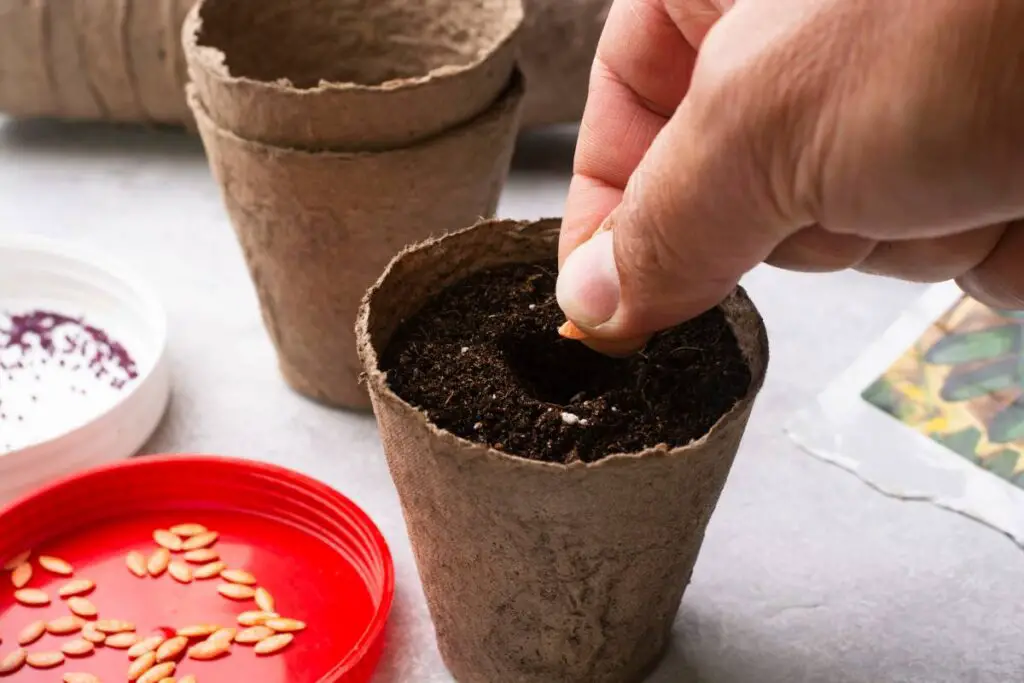
For outdoor planting, you need to prepare the ground of the planting site.
You can take any soil mix recipe from the previous section for the ideal soil mixes in the raised beds arranged in boxes or pots.
The cucumbers should be planted 2 weeks after the last frost.
Before planting the cucumbers in the ground, your preparation will start in the fall.
To prepare the bed in the fall for cucumber plantation after the frost:
- Dig the garden around 25 to 30 cm deep.
- Add 1m² 5 to 8 kgs of manure and 10 gms of fertilizer with high potassium and phosphorus content to the soil.
- For mulching, add some straws, sawdust, or birch leaves.
The soil dug up in the fall will become loose by the spring. If the soil does not improve or becomes too crumbly, prepare the soil again in the spring.
For spring preparation:
- Dig the soil bed again a week before planting, break all the soil lumps, and remove the weeds.
- Make grooves 20-30 cm deep and fill them with rotted manure, compost, hay, dry leaves, and sawdust at 5 kg per 1m².
- Fill up the grooves with fertile soil that is loose and covered with a film.
- One day before planting, add a mixture of 45 gms of superphosphate, 20 gms of saltpeter, and 30 gms of potassium salt.
- Next day, plant the cucumbers 24 inches apart.
Plant companions like sunflowers and corn if the planting site is an open space that doesn’t protect the plants from direct sunlight, winds, and drafts.
You can create a DIY shade using shade cloth or a structure like a pergola or an arbor.
Disinfecting the soil
A planting site under the open sky must be disinfected before planting so the new cucumbers do not develop any infectious diseases.
For that, you can try one disinfectant from the following:
- Dilute 1 teaspoon of potassium permanganate into 1 liter of hot water, immediately water the ground, and let it dry.
- Prepare a 3% solution of Bordeaux liquid and apply it to the soil after the fall digging.
- Dilute 5 gms of Fitosporin-M in 10 liters of water for 1m² and water the soil in the spring before sowing or planting seedlings. If you grow cucumbers in the greenhouse, spray this solution on the ceilings and walls.
Soil testing for the cucumber plants
The cucumbers need to grow in sandy, loamy, slightly acidic, and nutrient-rich soil.
Testing the soil for its nutrients and acidity level is necessary.
If you do not know how to check, here are some tips that I follow to test the soil:
- Observe the soil color closely. The nutrient-rich soils appear darker than nutrient-deficient soil.
- Take a handful of soil and squeeze it. A nutrient-poor soil will be loose and seep through your fingers. A nutrient-rich soil stays intact but breaks apart and becomes loose after squeezing.
- If the soil does not break after squeezing, it contains a lot of clay content which is not ideal for cucumber plants.
These are some natural ways to check the soil. You can send your soil sample to the laboratory for genuine confirmation.
Once you receive the nutrient level results, mend your soil accordingly.
To check the soil’s pH level, use litmus paper or any other pH tester from the market.
Another way to check the soil acidity is by dousing some dry garden soil with vinegar.
If there are tiny bubbles, the pH level is perfect for cucumbers. No reaction means the soil is sour and needs calcifying.
Cucumbers enjoy slightly acidic soil. The pH level should be between 6.0 and 6.5.
For highly acidic soil, add 200 to 300 gms of the following agents per 1 m:
- Gypsum
- Wood ash
- Limestone
- Slaked lime
Add aluminum sulfate, mild sulfuric acid, and sulfur for alkaline soils.
Common soil problems for cucumber plants and how to address them
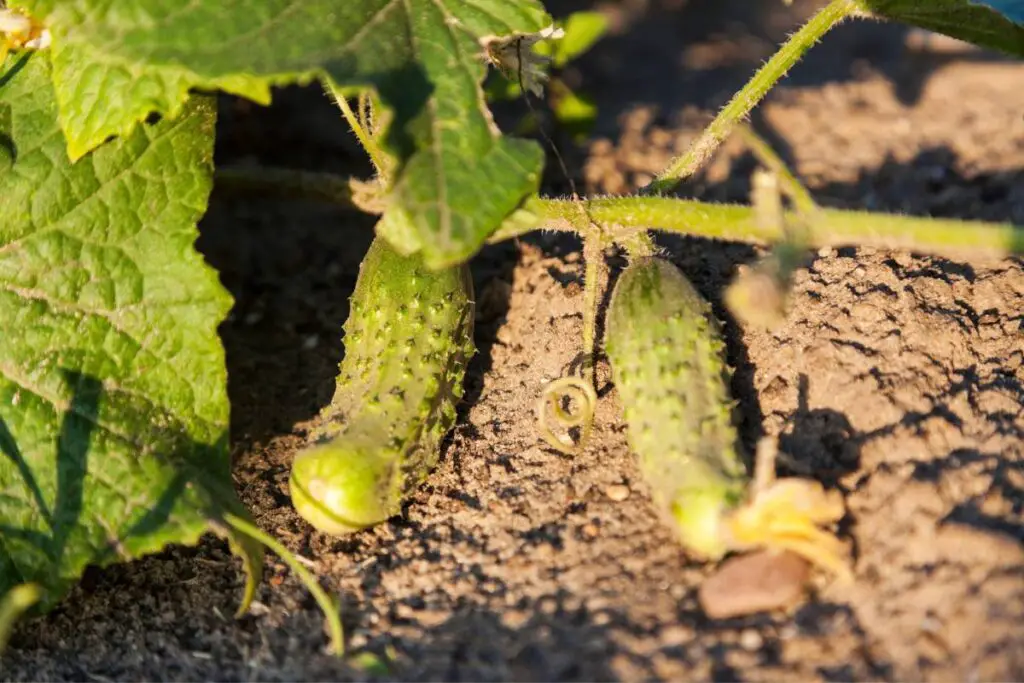
If you use the wrong type of soil for the cucumber plants, they will encounter several soil-related issues.
Below are some soil problems you will face if the soil type of unsuitable for the cucumber plants:
Poor drainage
The soil for the cucumbers must be well-drained and loamy, filled with organic matter.
A soil poor in drainage can lead to overwatering and root rot.
The water will drain very slowly; if you keep watering, it will remain stagnant around the roots.
As a result, the roots will suffocate and won’t be able to transport the nutrients and moisture to other plant parts.
Over time, the roots will begin to rot and damage the plant.
Add compost or increase the sand content in your soil to stop this.
Compact soil
Clayey soil can make the growing medium extremely compact, whether in pots or landscapes.
Compact soil can also lead to poor drainage. Further, it restricts the cucumber roots from spreading and further developing.
As a result, your plant will stop developing correctly.
Clayey soil is smooth and sticky to the touch when you squeeze it.
To fix compact soil, add organic matter like compost.
You can also use mulch. It will retain moisture and keep the soil moist for a long time, reducing the watering frequency.
Over time, it will break down and add nutrients to the soil.
Increase the gap between each watering and check the moisture level every time before watering.
Whenever the top few inches feel dry, water the plant.
Improper pH level
The pH should be between 6.0 and 6.5.
Higher pH levels can increase the soil’s calcium level, further interrupting the plant’s nutrient absorption and leading to stunted growth, yellowing, and reduced fruit production.
The soil’s aluminum and manganese content can increase in the soil with a lower pH level, harming the cucumbers.
It will reduce root growth and nutrient absorption, leading to stunted growth and zero fruit production.
If the pH is higher, adjust it by adding aluminum sulfate, mild sulfuric acid, and sulfur.
For lower pH levels, use lime, vinegar, or limestones.
Nutrient deficiency
Cucumbers need high amounts of potassium and phosphorus and low amounts of nitrogen.
Besides these, it also requires some micronutrients like magnesium, manganese, zinc, sulfur, calcium, and iron.
A deficiency of these nutrients leads to slow or stunted plant growth, slow root growth, and no fruits.
Even if there are any cucumbers, they will be fewer in number, smaller in size, and distorted.
The leaves will also be small, lose color, and turn yellow over time.
To fix this, add organic matter or mulch. Over time, the mulch breaks down and adds all the necessary nutrients to the soil.
How to improve your soil to grow cucumbers?
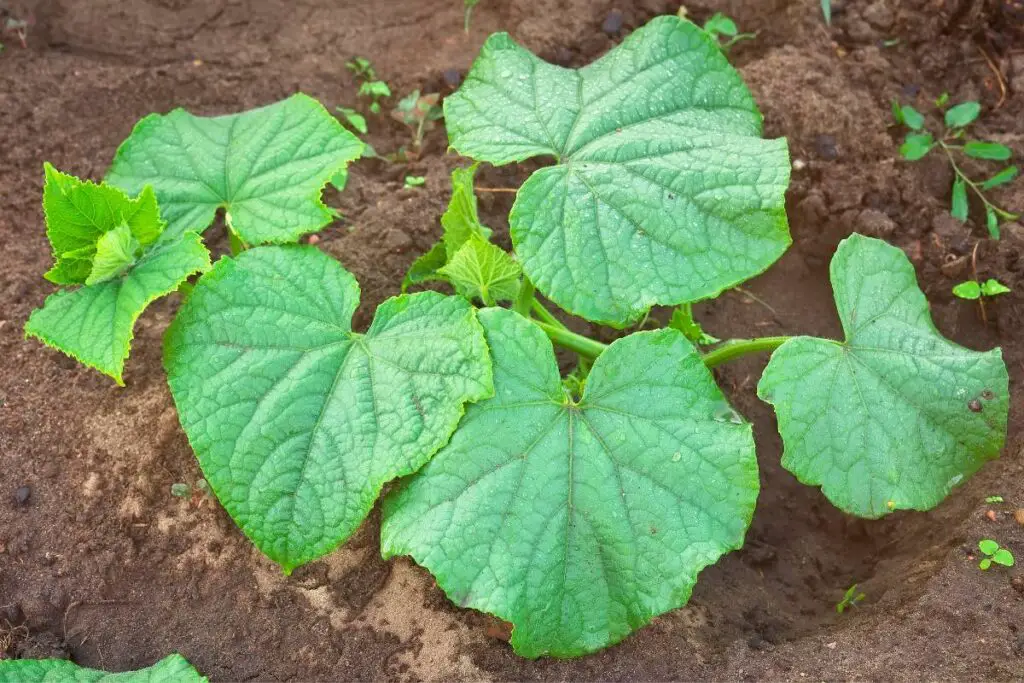
Garden soils are not always ideal for cucumbers. You can improve the soil quality instead of buying new soil.
With several experiences over the years, I have learned some small tips and tricks to improve the soil quality to make it ideal for cucumber growth.
You can try these by consulting other gardeners.
Here are the tips and tricks:
Add a layer of mulch
Adding a thick layer of mulch to the top few inches of the soil can significantly affect the soil quality.
Over time, the mulch will break down into small pieces of organic matter, making your soil nutritious for cucumber growth.
It will also help prevent the moisture from evaporating and retain it.
So, your cucumbers will always remain hydrated and never run out of water.
With this method, my plants gave so many tasty cucumbers that I lost count of them.
Introduce earthworms to the soil
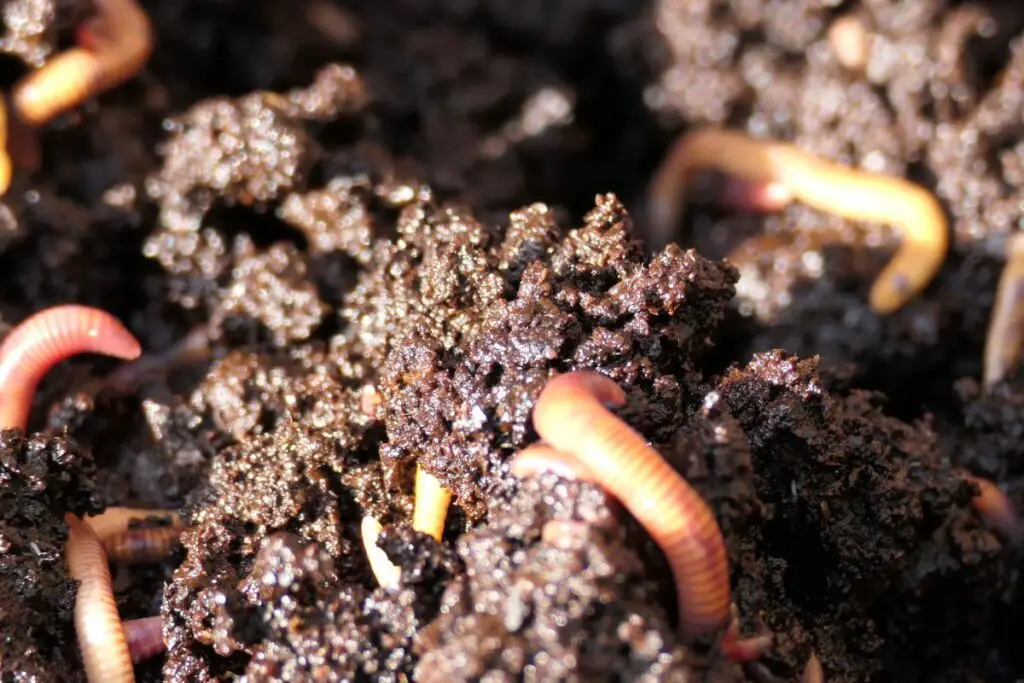
It was something that I recently started.
The earthworms keep moving around in the soil.
They loosen the soil and improve aeration and water permeability as they move.
Their excretion makes the soil perfect for cucumbers by mixing minerals and organic matter.
The activity of the earthworms in the soil will reduce soil compactness and make the nutrients and moisture available to the plants easy.
However, I found that it is not good to use earthworms all the time.
Since they are insects, earthworms might want to taste your garden’s tasty and plumpy cucumbers.
To counter the problem, grow your cucumber plants in a trellis to encourage them to grow upwards.
The earthworms will stay in the soil and do their job, and the trellis will keep the plant safer from them.
Add organic matter
If the soil is poor in nutrient levels, adding organic matter is one of the simple ways to improve soil quality.
Organic matter like compost is very beneficial for cucumbers.
Not only does it improve the nutrient level, but it also helps in improving drainage and moisture retention.
Mix sand into the soil
Adding sand is an easy way of improving drainage.
Cucumbers enjoy well-drained loamy soil for vigorous growth.
If the soil is poor in drainage or compact, adding sand can improve the drainage and make the soil suitable for the cucumbers.
First, check the loaminess of the soil by picking up some soil and squeezing it.
If some soil amount remains compact, add the sand according to the soil’s rigidness.
When you squeeze the soil, and it crumbles with a light poke, that is the soil you need for cucumbers.
Till the soil before planting
Dig until the top few inches of the planting site before planting the cucumbers.
It will help loosen the soil, remove the compactness, and make it loamy and ideal for the cucumbers.
Adjust the pH level
Cucumbers love slightly acidic soil. If your soil is high or low in pH, you can mend it by adding some elements.
The ideal pH level is between 6 and 6.5.
If the pH is low, add lime as ground limestone or wood ash to raise the pH level.
For higher pH levels, add sulfur in the form of elemental sulfur, iron sulfate, and fertilizers with low ammonium sulfate.
Test the soil’s alkalinity before you plant cucumbers.
Final thoughts
The ideal type of soil for cucumber plants is well-drained, loamy soil filled with organic matter. The pH level should range between 6.0 and 6.5, and the temperature should be between 70 to 90°F. Both organic and inorganic soil types will work for the cucumber plants, provided their requirements are met.
However, organic soil is preferred the most as it is natural, high in nutrients, and slowly adds nutrients to the soil. You can try the soil recipes or the commercial soils I have shared in the article.
If the soil quality is not up to the mark, add mulch, organic matter, sand, and earthworms. Aerate the soil and adjust the pH levels accordingly.
How do I process the garden after harvesting the cucumbers?
Once you have done the final harvest, remove all the whips and weeds from the garden, dig up the ground, and spray it with trichodermin solution. For 10 m², dilute 2-5 gms of the product with 1 liter of water.
Is Epsom salt good for cucumbers?
Epsom salt contains high amounts of sulfur and magnesium. So, it can serve these plants with sufficient nutrient sources for healthy growth. Use only 1 tablespoon of salt for every half-acre bed with fertilizers.
Reference: Cucumber Soil Wikipedia

